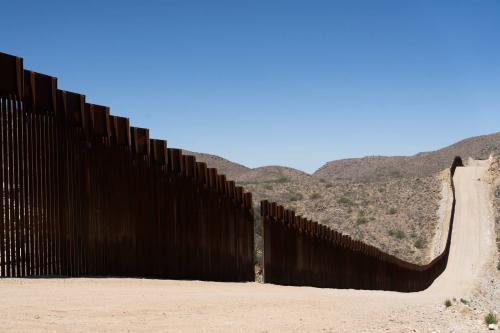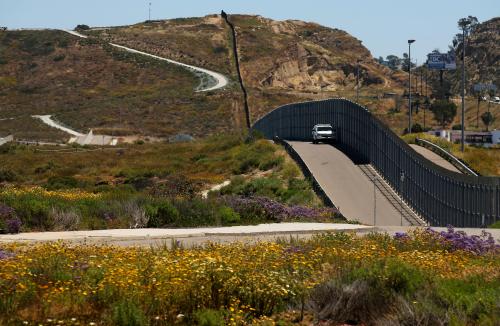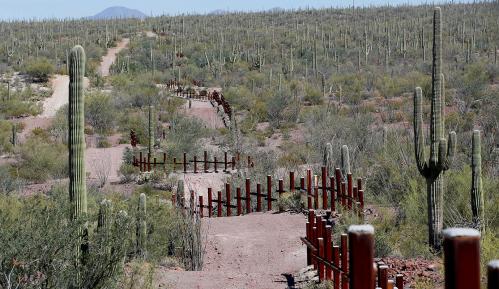As President Trump has no doubt just discovered, there are very few genuinely new ideas in government. Take, for instance, his latest pronouncement: “Until we have a wall and proper security, we’re going to be guarding our border with the military… That’s a big step. We really haven’t done that before.”
Well, actually we have done that before. Though it was not immediately clear what the president meant by his seemingly impromptu proclamation, the White House eventually clarified that the strategy would rely on mobilizing the National Guard. So by now, someone has probably told President Trump that those two weak-kneed presidents that preceded him did exactly what he is suggesting. From June 2006 to July 2008 when George W. Bush was president, he sent 6,000 National Guard troops to help out Border Patrol in California, Arizona, New Mexico, and Texas. And then again from July 2010 to September 2011, when Barack Obama was president, he deployed 1,200 soldiers and airmen along the 1,933 mile southwest border where they served as a “force multiplier,” spotting intrusions and providing technical support.
Aside from the normal Trumpian hyperbole, there are two major problems with President Trump’s announcement that he would use the military on the border between the United States and Mexico. The first involves long-standing legal restrictions on the use of the military in domestic law enforcement and the second, perhaps bigger, problem is: why now?
Under a law passed in 1878 called the Posse Comitatus Act, the United States military is prohibited from operating on American soil in a law enforcement capacity. The law, originally part of the withdrawal of Union forces from the occupied South after the Civil War, has become such a centerpiece of American government that many people assume, mistakenly, that it is part of the Constitution.
Over the years, there have been some carefully drawn exceptions written into the law. Title 32, for instance, allows National Guard personnel to participate in law enforcement activities but, as GAO notes, the Secretary of Defense has prohibited them from making arrests and seizures at the border, fearing that that would cross the line into militarizing the border. When I was in the White House in 1996 we discovered that security for the Atlanta Olympics that year was in serious trouble. After much haggling with the Defense Department, soldiers (out of uniform) were assigned to drive the buses into the secure perimeter where the games were being held.
These days, the National Guard can be called on under three carefully delineated circumstances. According to GAO they are:
“(1) state status—state funded under the command and control of the governor;
(2) Title 32 status—federally funded under command and control of the governor (Title 32 forces may participate in law enforcement activities); and
(3) Title 10 status—federally funded under command and control of the Secretary of Defense. Forces serving in Title 10 status are generally prohibited from direct participation in law enforcement activities, without proper statutory authorization, but may work to support civilian law enforcement.”
Therefore, injecting the military into domestic law enforcement operations is possible but not without introducing potential problems. It diverts military resources from other operations that are perhaps more important, and it is costly (GAO estimates that the Bush and Obama operations cost over $1.3 billion). And finally, at the core of the restrictions is the fact that the National Guard cannot arrest the people they help identify—only the border patrol agents can.
But perhaps the bigger problem is that militarizing the border now sounds suspiciously like a ploy to energize Trump’s base before the midterm elections rather than a sound response to an actual problem. First of all, the number of unauthorized immigrants in the United States has been decreasing rather than increasing ever since the Great Recession reduced job opportunities in the United States, as has the number of apprehensions at the border.
Second, the number of Mexicans has been decreasing as a proportion of the total population of unauthorized immigrants in the U.S.—so while militarizing the border with Mexico could help, it doesn’t begin to address all the people who come in on tourist or other visas and stay. Furthermore, the 1000-plus, mostly Honduran refugees now marching into Mexico are part of a demonstration that has been going on annually for several years in order to draw attention to the plight of migrants—and they are being evaluated for asylum protections by the Mexican government.
All of this said, Donald Trump fueled fear and loathing of unauthorized immigrants and turned it into a path to the White House. But faced with the reality of the situation, Congress has rightfully concluded (several times now) that they have other things to spend money on than Trump’s border wall. And so his latest gambit is just one more instance of trying to milk the immigration issue for every ounce of its political juice.








Commentary
Rebuffed by Congress, Trump resorts to old ideas on the border
April 4, 2018